Comprehensive Financial Accounting Report: Brooks City Case Study
VerifiedAdded on 2021/02/20
|30
|6425
|19
Report
AI Summary
This report delves into financial accounting principles, examining their significance and purpose within the context of Brooks City, a small business accountancy firm. It covers the definition of financial accounting, its major purposes, and the preparation of financial statements. The report identifies and describes both internal (managers and owners) and external stakeholders (lenders, investors, auditors, and government), highlighting their respective interests in financial reporting. It includes detailed journal entries for January 2019, illustrating transaction recording. Furthermore, the report provides insights into accounting concepts like depreciation, suspense, and control accounts, as well as Bank Reconciliation Statements (BRS) and the causes of deviations in comparison to cash flow statements, offering a comprehensive overview of financial accounting practices.
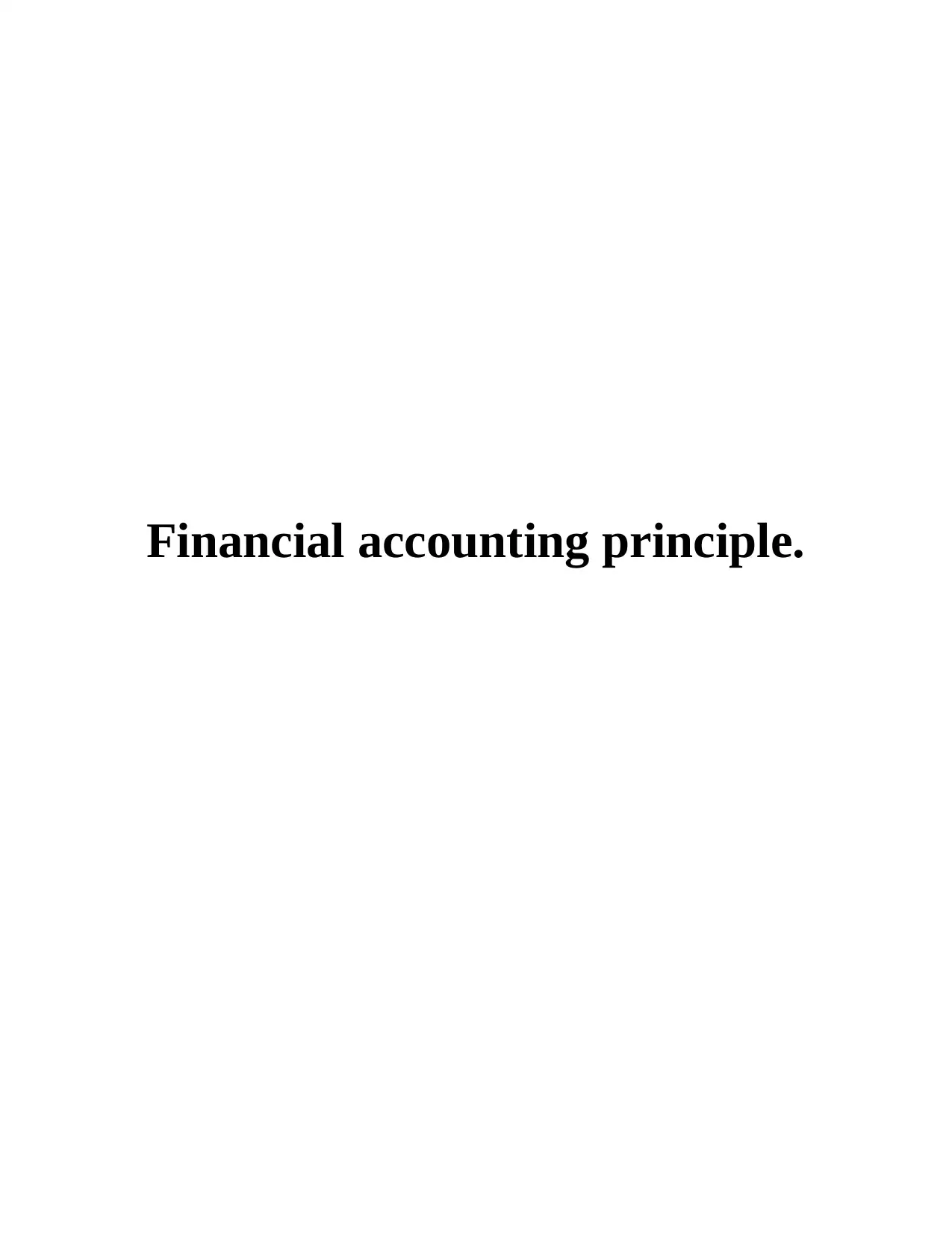
Financial accounting principle.
Paraphrase This Document
Need a fresh take? Get an instant paraphrase of this document with our AI Paraphraser
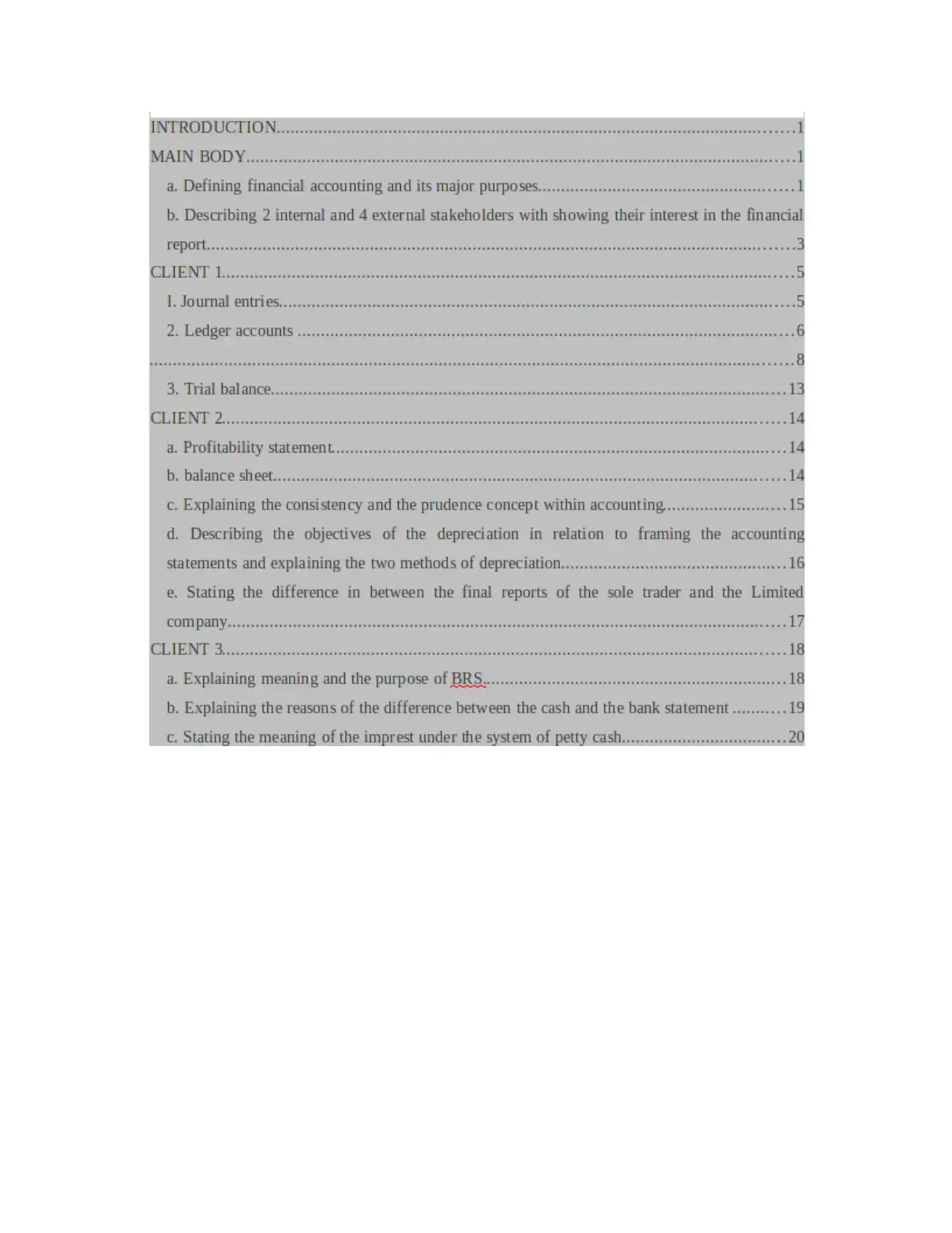
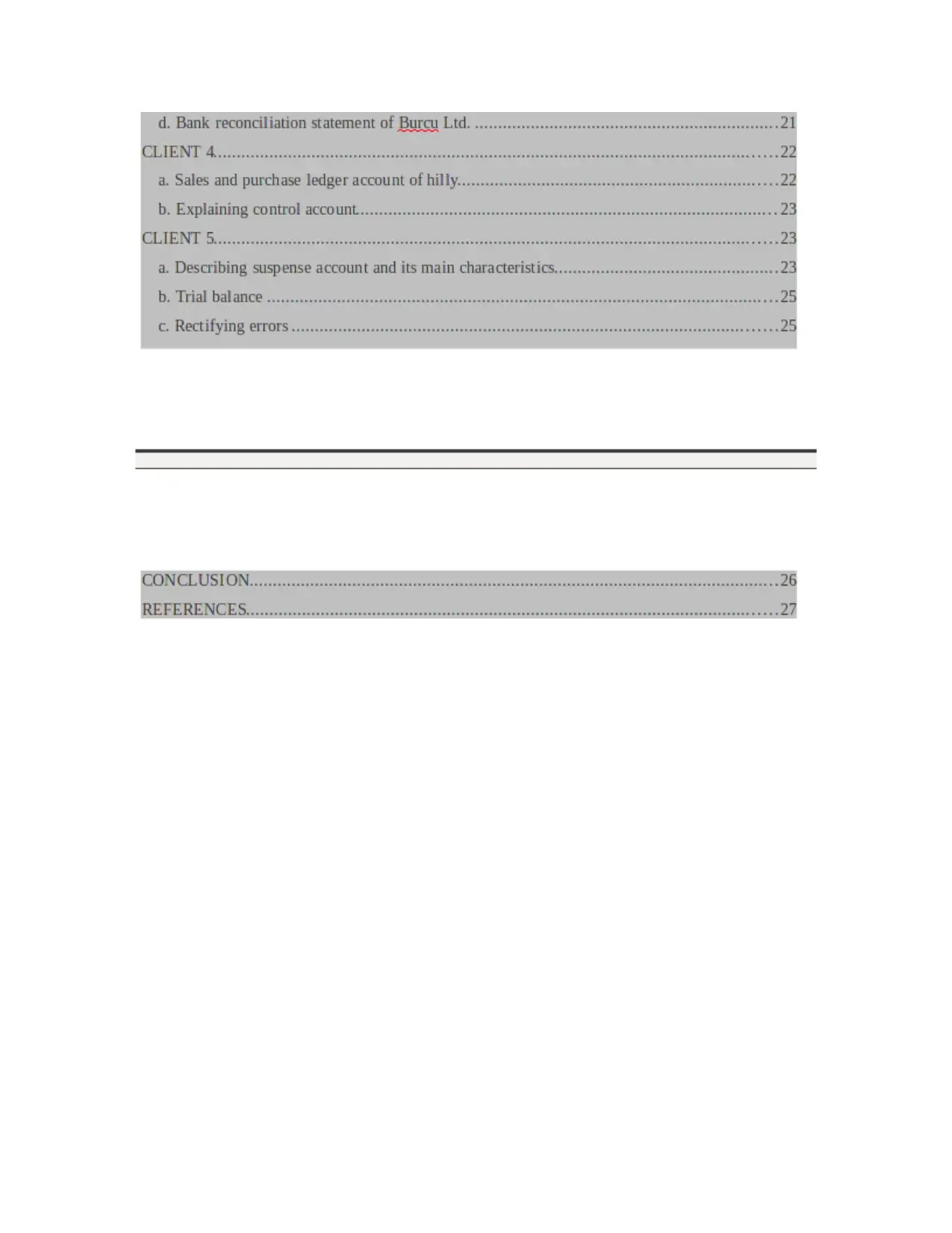
⊘ This is a preview!⊘
Do you want full access?
Subscribe today to unlock all pages.

Trusted by 1+ million students worldwide
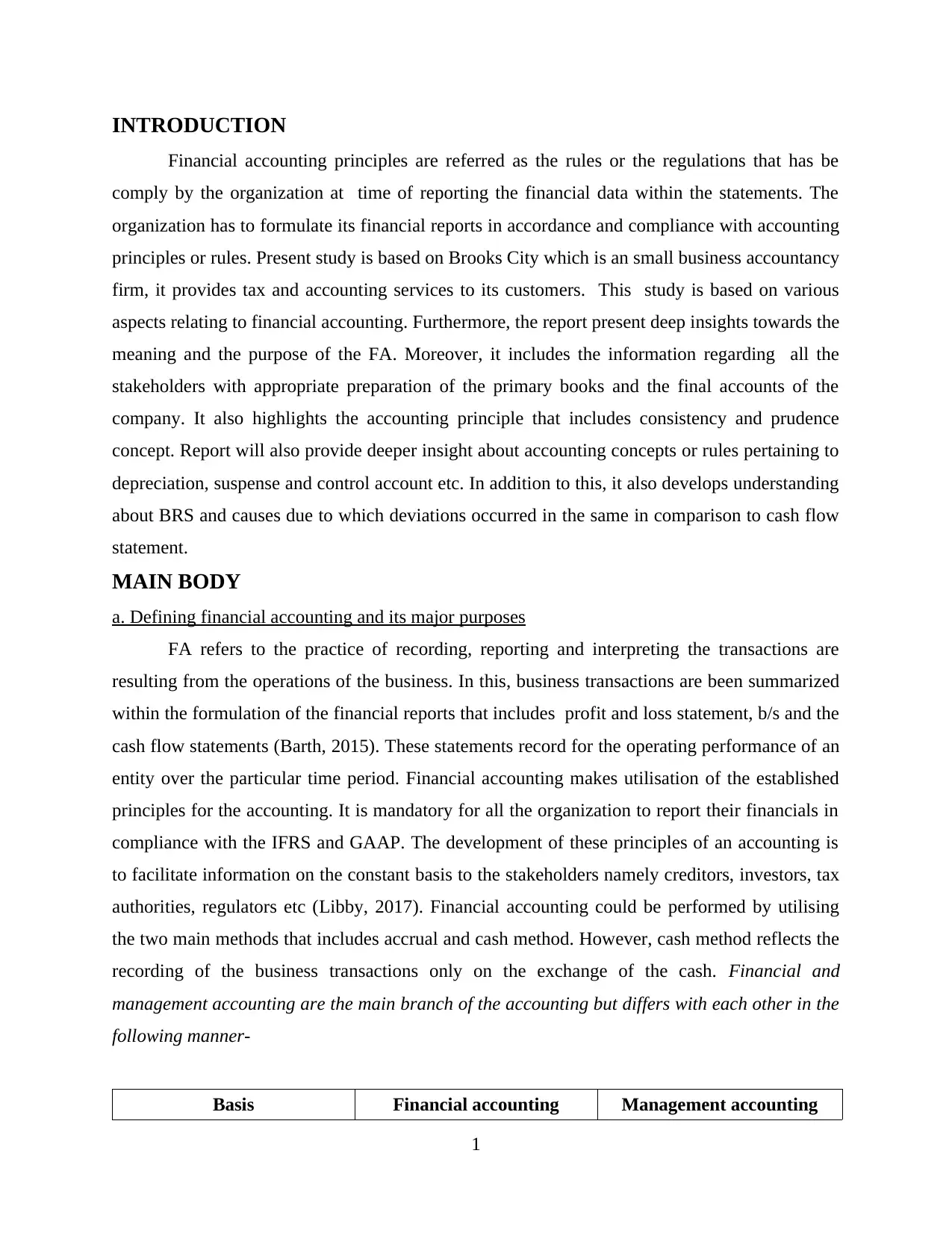
INTRODUCTION
Financial accounting principles are referred as the rules or the regulations that has be
comply by the organization at time of reporting the financial data within the statements. The
organization has to formulate its financial reports in accordance and compliance with accounting
principles or rules. Present study is based on Brooks City which is an small business accountancy
firm, it provides tax and accounting services to its customers. This study is based on various
aspects relating to financial accounting. Furthermore, the report present deep insights towards the
meaning and the purpose of the FA. Moreover, it includes the information regarding all the
stakeholders with appropriate preparation of the primary books and the final accounts of the
company. It also highlights the accounting principle that includes consistency and prudence
concept. Report will also provide deeper insight about accounting concepts or rules pertaining to
depreciation, suspense and control account etc. In addition to this, it also develops understanding
about BRS and causes due to which deviations occurred in the same in comparison to cash flow
statement.
MAIN BODY
a. Defining financial accounting and its major purposes
FA refers to the practice of recording, reporting and interpreting the transactions are
resulting from the operations of the business. In this, business transactions are been summarized
within the formulation of the financial reports that includes profit and loss statement, b/s and the
cash flow statements (Barth, 2015). These statements record for the operating performance of an
entity over the particular time period. Financial accounting makes utilisation of the established
principles for the accounting. It is mandatory for all the organization to report their financials in
compliance with the IFRS and GAAP. The development of these principles of an accounting is
to facilitate information on the constant basis to the stakeholders namely creditors, investors, tax
authorities, regulators etc (Libby, 2017). Financial accounting could be performed by utilising
the two main methods that includes accrual and cash method. However, cash method reflects the
recording of the business transactions only on the exchange of the cash. Financial and
management accounting are the main branch of the accounting but differs with each other in the
following manner-
Basis Financial accounting Management accounting
1
Financial accounting principles are referred as the rules or the regulations that has be
comply by the organization at time of reporting the financial data within the statements. The
organization has to formulate its financial reports in accordance and compliance with accounting
principles or rules. Present study is based on Brooks City which is an small business accountancy
firm, it provides tax and accounting services to its customers. This study is based on various
aspects relating to financial accounting. Furthermore, the report present deep insights towards the
meaning and the purpose of the FA. Moreover, it includes the information regarding all the
stakeholders with appropriate preparation of the primary books and the final accounts of the
company. It also highlights the accounting principle that includes consistency and prudence
concept. Report will also provide deeper insight about accounting concepts or rules pertaining to
depreciation, suspense and control account etc. In addition to this, it also develops understanding
about BRS and causes due to which deviations occurred in the same in comparison to cash flow
statement.
MAIN BODY
a. Defining financial accounting and its major purposes
FA refers to the practice of recording, reporting and interpreting the transactions are
resulting from the operations of the business. In this, business transactions are been summarized
within the formulation of the financial reports that includes profit and loss statement, b/s and the
cash flow statements (Barth, 2015). These statements record for the operating performance of an
entity over the particular time period. Financial accounting makes utilisation of the established
principles for the accounting. It is mandatory for all the organization to report their financials in
compliance with the IFRS and GAAP. The development of these principles of an accounting is
to facilitate information on the constant basis to the stakeholders namely creditors, investors, tax
authorities, regulators etc (Libby, 2017). Financial accounting could be performed by utilising
the two main methods that includes accrual and cash method. However, cash method reflects the
recording of the business transactions only on the exchange of the cash. Financial and
management accounting are the main branch of the accounting but differs with each other in the
following manner-
Basis Financial accounting Management accounting
1
Paraphrase This Document
Need a fresh take? Get an instant paraphrase of this document with our AI Paraphraser
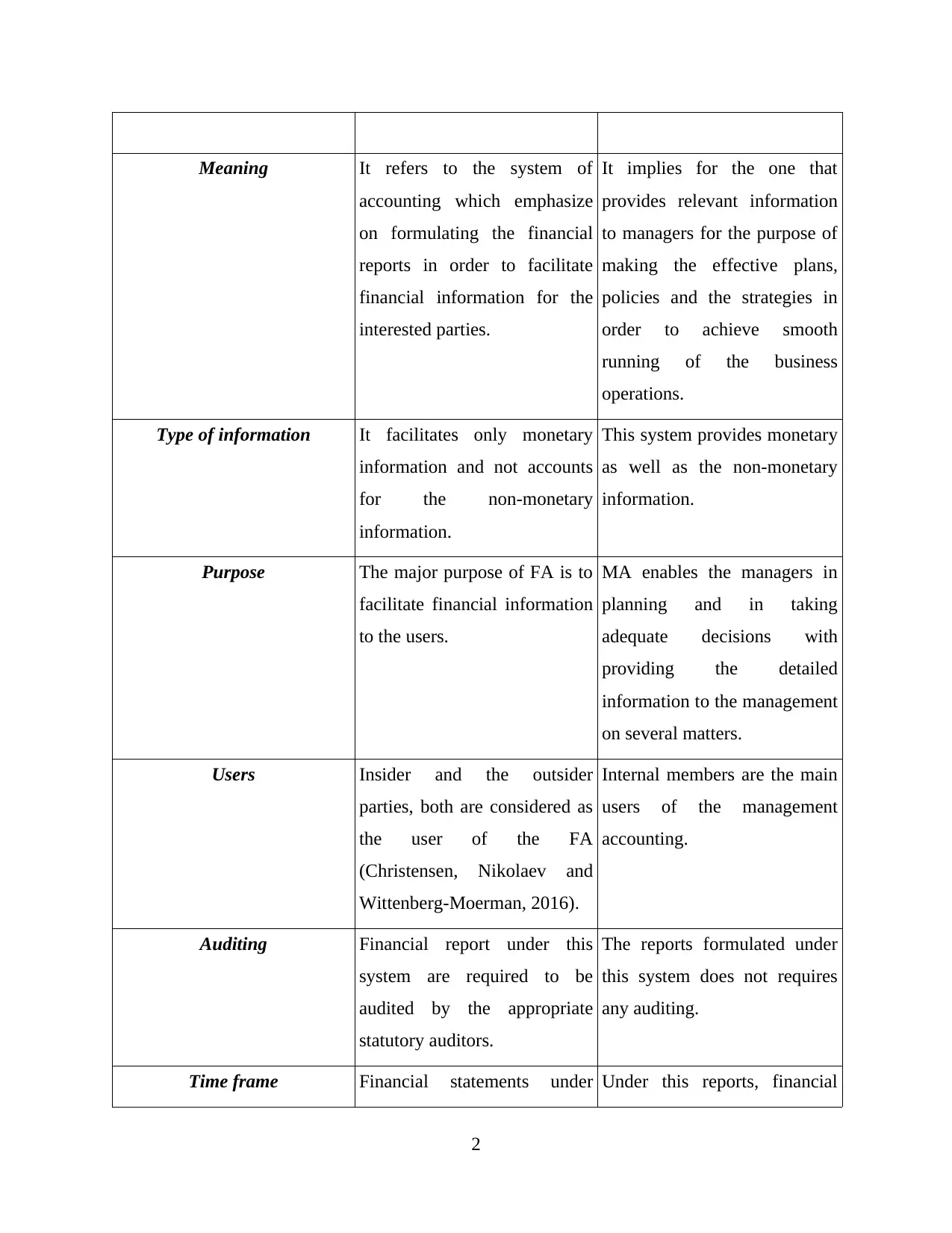
Meaning It refers to the system of
accounting which emphasize
on formulating the financial
reports in order to facilitate
financial information for the
interested parties.
It implies for the one that
provides relevant information
to managers for the purpose of
making the effective plans,
policies and the strategies in
order to achieve smooth
running of the business
operations.
Type of information It facilitates only monetary
information and not accounts
for the non-monetary
information.
This system provides monetary
as well as the non-monetary
information.
Purpose The major purpose of FA is to
facilitate financial information
to the users.
MA enables the managers in
planning and in taking
adequate decisions with
providing the detailed
information to the management
on several matters.
Users Insider and the outsider
parties, both are considered as
the user of the FA
(Christensen, Nikolaev and
Wittenberg‐Moerman, 2016).
Internal members are the main
users of the management
accounting.
Auditing Financial report under this
system are required to be
audited by the appropriate
statutory auditors.
The reports formulated under
this system does not requires
any auditing.
Time frame Financial statements under Under this reports, financial
2
accounting which emphasize
on formulating the financial
reports in order to facilitate
financial information for the
interested parties.
It implies for the one that
provides relevant information
to managers for the purpose of
making the effective plans,
policies and the strategies in
order to achieve smooth
running of the business
operations.
Type of information It facilitates only monetary
information and not accounts
for the non-monetary
information.
This system provides monetary
as well as the non-monetary
information.
Purpose The major purpose of FA is to
facilitate financial information
to the users.
MA enables the managers in
planning and in taking
adequate decisions with
providing the detailed
information to the management
on several matters.
Users Insider and the outsider
parties, both are considered as
the user of the FA
(Christensen, Nikolaev and
Wittenberg‐Moerman, 2016).
Internal members are the main
users of the management
accounting.
Auditing Financial report under this
system are required to be
audited by the appropriate
statutory auditors.
The reports formulated under
this system does not requires
any auditing.
Time frame Financial statements under Under this reports, financial
2
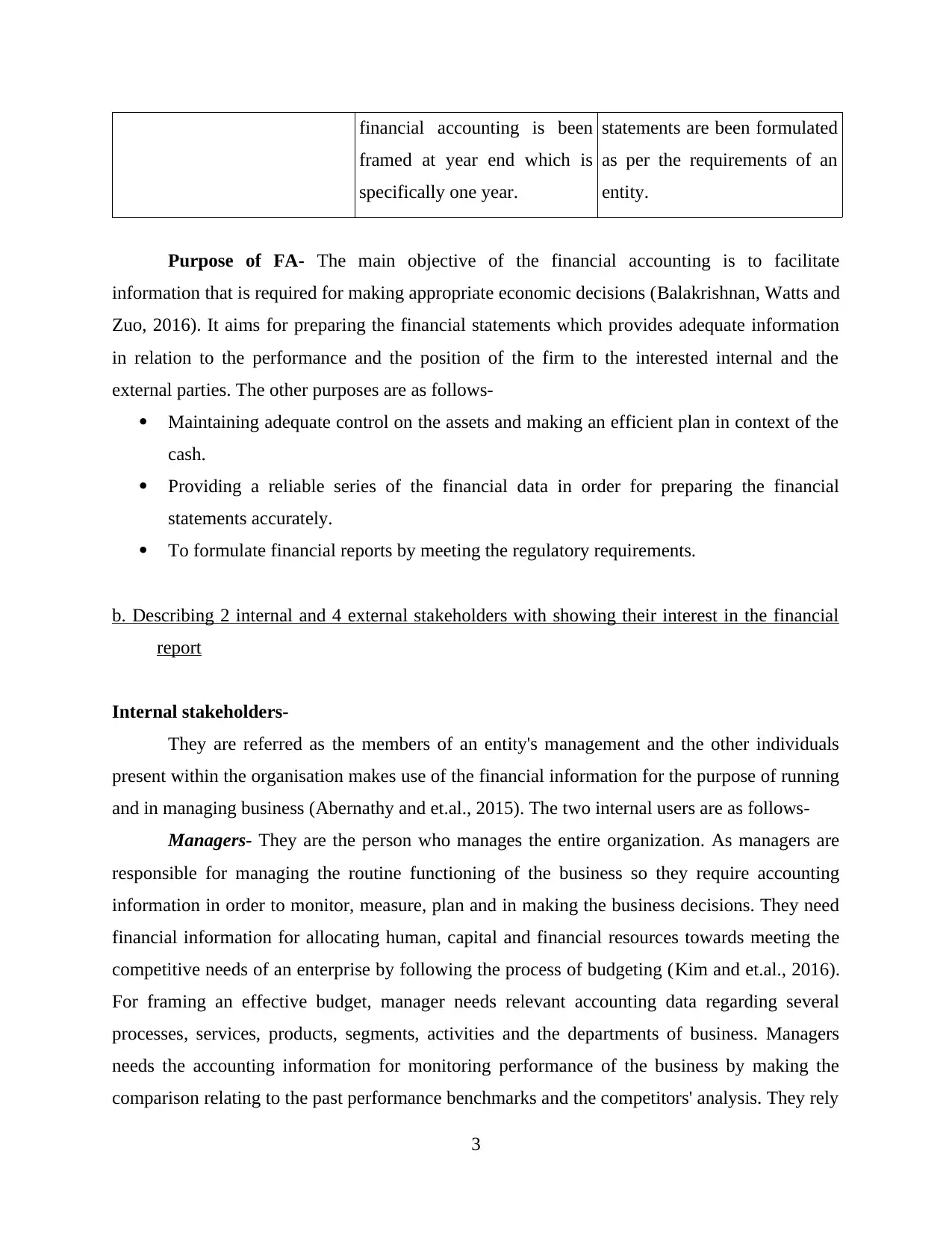
financial accounting is been
framed at year end which is
specifically one year.
statements are been formulated
as per the requirements of an
entity.
Purpose of FA- The main objective of the financial accounting is to facilitate
information that is required for making appropriate economic decisions (Balakrishnan, Watts and
Zuo, 2016). It aims for preparing the financial statements which provides adequate information
in relation to the performance and the position of the firm to the interested internal and the
external parties. The other purposes are as follows-
Maintaining adequate control on the assets and making an efficient plan in context of the
cash.
Providing a reliable series of the financial data in order for preparing the financial
statements accurately.
To formulate financial reports by meeting the regulatory requirements.
b. Describing 2 internal and 4 external stakeholders with showing their interest in the financial
report
Internal stakeholders-
They are referred as the members of an entity's management and the other individuals
present within the organisation makes use of the financial information for the purpose of running
and in managing business (Abernathy and et.al., 2015). The two internal users are as follows-
Managers- They are the person who manages the entire organization. As managers are
responsible for managing the routine functioning of the business so they require accounting
information in order to monitor, measure, plan and in making the business decisions. They need
financial information for allocating human, capital and financial resources towards meeting the
competitive needs of an enterprise by following the process of budgeting (Kim and et.al., 2016).
For framing an effective budget, manager needs relevant accounting data regarding several
processes, services, products, segments, activities and the departments of business. Managers
needs the accounting information for monitoring performance of the business by making the
comparison relating to the past performance benchmarks and the competitors' analysis. They rely
3
framed at year end which is
specifically one year.
statements are been formulated
as per the requirements of an
entity.
Purpose of FA- The main objective of the financial accounting is to facilitate
information that is required for making appropriate economic decisions (Balakrishnan, Watts and
Zuo, 2016). It aims for preparing the financial statements which provides adequate information
in relation to the performance and the position of the firm to the interested internal and the
external parties. The other purposes are as follows-
Maintaining adequate control on the assets and making an efficient plan in context of the
cash.
Providing a reliable series of the financial data in order for preparing the financial
statements accurately.
To formulate financial reports by meeting the regulatory requirements.
b. Describing 2 internal and 4 external stakeholders with showing their interest in the financial
report
Internal stakeholders-
They are referred as the members of an entity's management and the other individuals
present within the organisation makes use of the financial information for the purpose of running
and in managing business (Abernathy and et.al., 2015). The two internal users are as follows-
Managers- They are the person who manages the entire organization. As managers are
responsible for managing the routine functioning of the business so they require accounting
information in order to monitor, measure, plan and in making the business decisions. They need
financial information for allocating human, capital and financial resources towards meeting the
competitive needs of an enterprise by following the process of budgeting (Kim and et.al., 2016).
For framing an effective budget, manager needs relevant accounting data regarding several
processes, services, products, segments, activities and the departments of business. Managers
needs the accounting information for monitoring performance of the business by making the
comparison relating to the past performance benchmarks and the competitors' analysis. They rely
3
⊘ This is a preview!⊘
Do you want full access?
Subscribe today to unlock all pages.

Trusted by 1+ million students worldwide
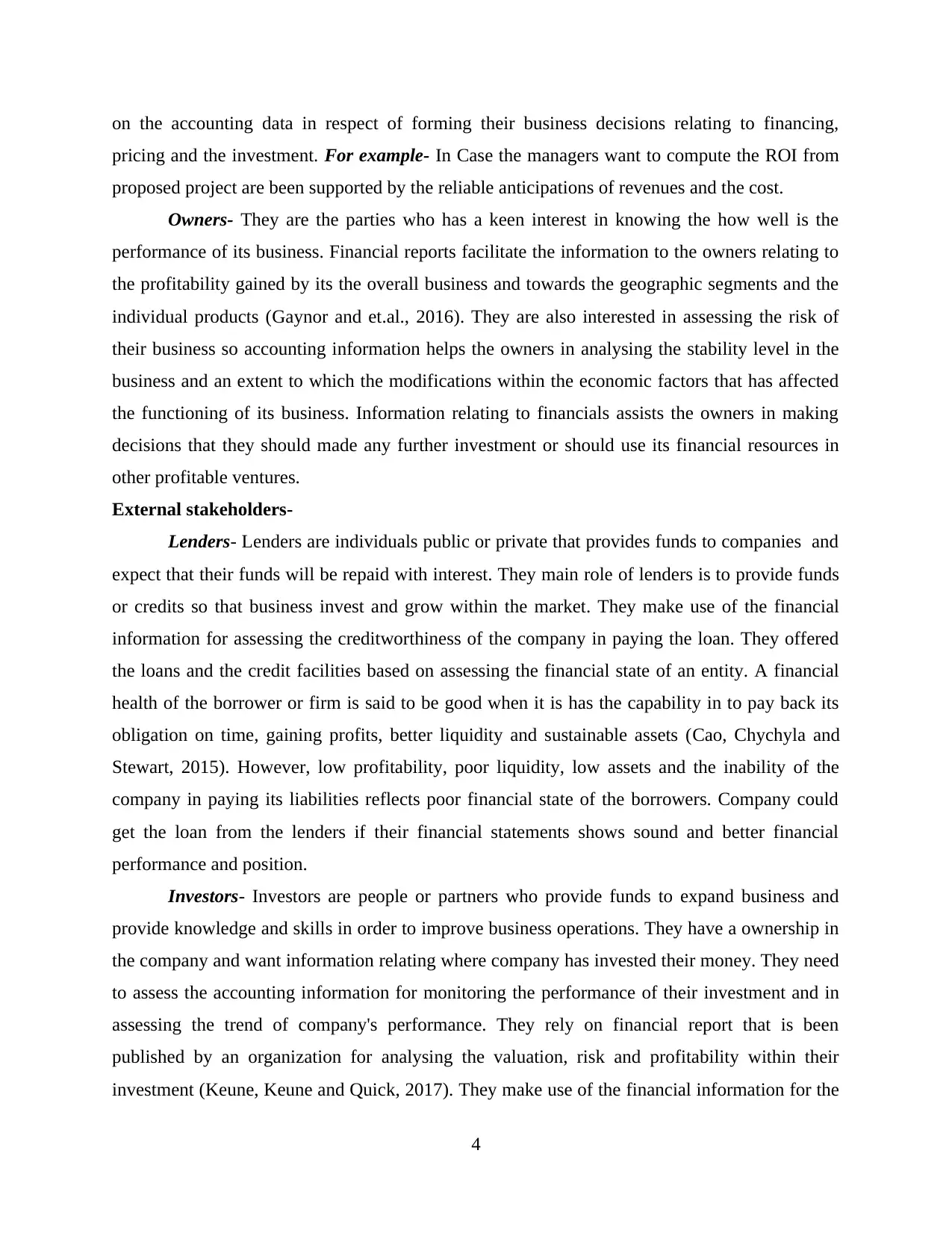
on the accounting data in respect of forming their business decisions relating to financing,
pricing and the investment. For example- In Case the managers want to compute the ROI from
proposed project are been supported by the reliable anticipations of revenues and the cost.
Owners- They are the parties who has a keen interest in knowing the how well is the
performance of its business. Financial reports facilitate the information to the owners relating to
the profitability gained by its the overall business and towards the geographic segments and the
individual products (Gaynor and et.al., 2016). They are also interested in assessing the risk of
their business so accounting information helps the owners in analysing the stability level in the
business and an extent to which the modifications within the economic factors that has affected
the functioning of its business. Information relating to financials assists the owners in making
decisions that they should made any further investment or should use its financial resources in
other profitable ventures.
External stakeholders-
Lenders- Lenders are individuals public or private that provides funds to companies and
expect that their funds will be repaid with interest. They main role of lenders is to provide funds
or credits so that business invest and grow within the market. They make use of the financial
information for assessing the creditworthiness of the company in paying the loan. They offered
the loans and the credit facilities based on assessing the financial state of an entity. A financial
health of the borrower or firm is said to be good when it is has the capability in to pay back its
obligation on time, gaining profits, better liquidity and sustainable assets (Cao, Chychyla and
Stewart, 2015). However, low profitability, poor liquidity, low assets and the inability of the
company in paying its liabilities reflects poor financial state of the borrowers. Company could
get the loan from the lenders if their financial statements shows sound and better financial
performance and position.
Investors- Investors are people or partners who provide funds to expand business and
provide knowledge and skills in order to improve business operations. They have a ownership in
the company and want information relating where company has invested their money. They need
to assess the accounting information for monitoring the performance of their investment and in
assessing the trend of company's performance. They rely on financial report that is been
published by an organization for analysing the valuation, risk and profitability within their
investment (Keune, Keune and Quick, 2017). They make use of the financial information for the
4
pricing and the investment. For example- In Case the managers want to compute the ROI from
proposed project are been supported by the reliable anticipations of revenues and the cost.
Owners- They are the parties who has a keen interest in knowing the how well is the
performance of its business. Financial reports facilitate the information to the owners relating to
the profitability gained by its the overall business and towards the geographic segments and the
individual products (Gaynor and et.al., 2016). They are also interested in assessing the risk of
their business so accounting information helps the owners in analysing the stability level in the
business and an extent to which the modifications within the economic factors that has affected
the functioning of its business. Information relating to financials assists the owners in making
decisions that they should made any further investment or should use its financial resources in
other profitable ventures.
External stakeholders-
Lenders- Lenders are individuals public or private that provides funds to companies and
expect that their funds will be repaid with interest. They main role of lenders is to provide funds
or credits so that business invest and grow within the market. They make use of the financial
information for assessing the creditworthiness of the company in paying the loan. They offered
the loans and the credit facilities based on assessing the financial state of an entity. A financial
health of the borrower or firm is said to be good when it is has the capability in to pay back its
obligation on time, gaining profits, better liquidity and sustainable assets (Cao, Chychyla and
Stewart, 2015). However, low profitability, poor liquidity, low assets and the inability of the
company in paying its liabilities reflects poor financial state of the borrowers. Company could
get the loan from the lenders if their financial statements shows sound and better financial
performance and position.
Investors- Investors are people or partners who provide funds to expand business and
provide knowledge and skills in order to improve business operations. They have a ownership in
the company and want information relating where company has invested their money. They need
to assess the accounting information for monitoring the performance of their investment and in
assessing the trend of company's performance. They rely on financial report that is been
published by an organization for analysing the valuation, risk and profitability within their
investment (Keune, Keune and Quick, 2017). They make use of the financial information for the
4
Paraphrase This Document
Need a fresh take? Get an instant paraphrase of this document with our AI Paraphraser
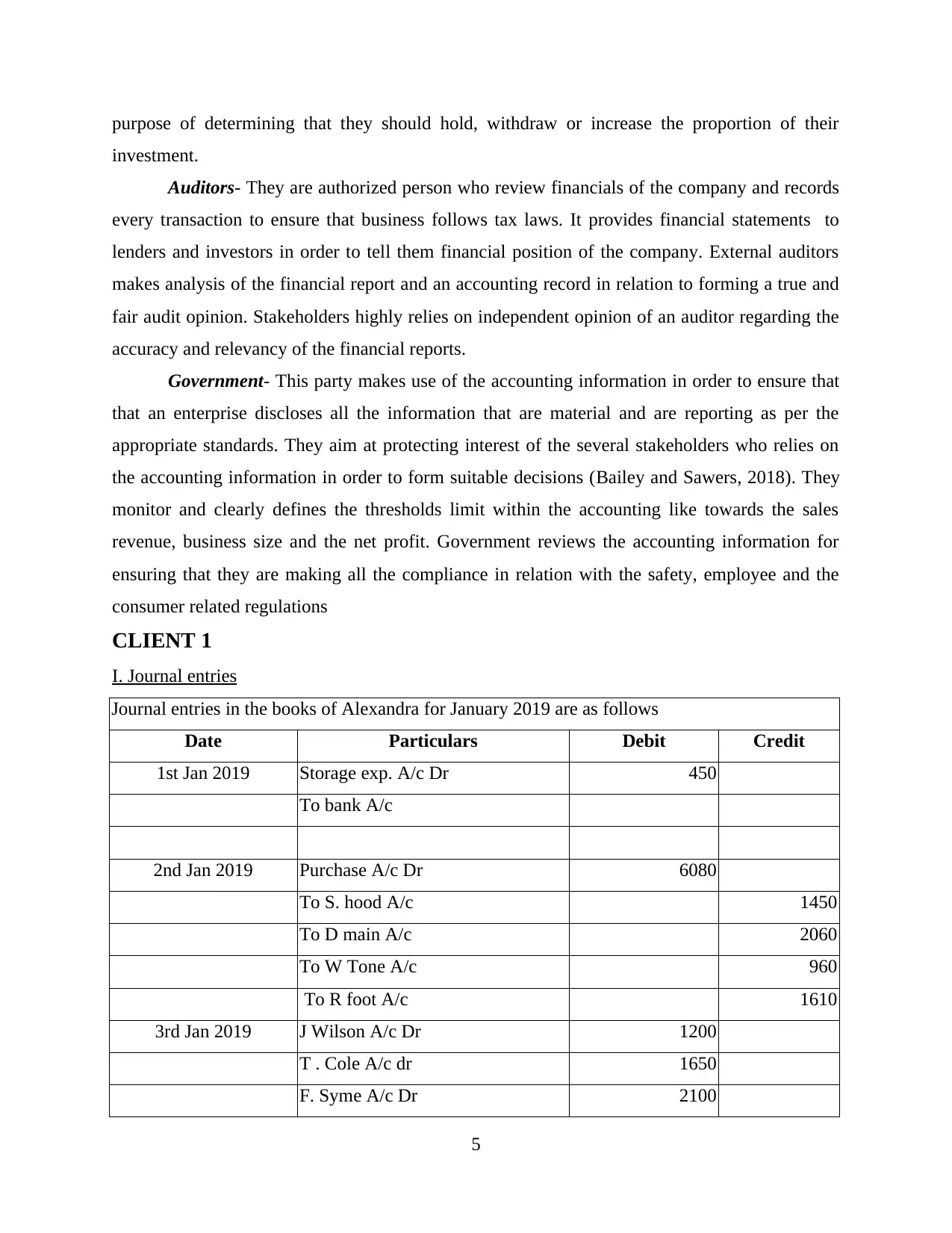
purpose of determining that they should hold, withdraw or increase the proportion of their
investment.
Auditors- They are authorized person who review financials of the company and records
every transaction to ensure that business follows tax laws. It provides financial statements to
lenders and investors in order to tell them financial position of the company. External auditors
makes analysis of the financial report and an accounting record in relation to forming a true and
fair audit opinion. Stakeholders highly relies on independent opinion of an auditor regarding the
accuracy and relevancy of the financial reports.
Government- This party makes use of the accounting information in order to ensure that
that an enterprise discloses all the information that are material and are reporting as per the
appropriate standards. They aim at protecting interest of the several stakeholders who relies on
the accounting information in order to form suitable decisions (Bailey and Sawers, 2018). They
monitor and clearly defines the thresholds limit within the accounting like towards the sales
revenue, business size and the net profit. Government reviews the accounting information for
ensuring that they are making all the compliance in relation with the safety, employee and the
consumer related regulations
CLIENT 1
I. Journal entries
Journal entries in the books of Alexandra for January 2019 are as follows
Date Particulars Debit Credit
1st Jan 2019 Storage exp. A/c Dr 450
To bank A/c
2nd Jan 2019 Purchase A/c Dr 6080
To S. hood A/c 1450
To D main A/c 2060
To W Tone A/c 960
To R foot A/c 1610
3rd Jan 2019 J Wilson A/c Dr 1200
T . Cole A/c dr 1650
F. Syme A/c Dr 2100
5
investment.
Auditors- They are authorized person who review financials of the company and records
every transaction to ensure that business follows tax laws. It provides financial statements to
lenders and investors in order to tell them financial position of the company. External auditors
makes analysis of the financial report and an accounting record in relation to forming a true and
fair audit opinion. Stakeholders highly relies on independent opinion of an auditor regarding the
accuracy and relevancy of the financial reports.
Government- This party makes use of the accounting information in order to ensure that
that an enterprise discloses all the information that are material and are reporting as per the
appropriate standards. They aim at protecting interest of the several stakeholders who relies on
the accounting information in order to form suitable decisions (Bailey and Sawers, 2018). They
monitor and clearly defines the thresholds limit within the accounting like towards the sales
revenue, business size and the net profit. Government reviews the accounting information for
ensuring that they are making all the compliance in relation with the safety, employee and the
consumer related regulations
CLIENT 1
I. Journal entries
Journal entries in the books of Alexandra for January 2019 are as follows
Date Particulars Debit Credit
1st Jan 2019 Storage exp. A/c Dr 450
To bank A/c
2nd Jan 2019 Purchase A/c Dr 6080
To S. hood A/c 1450
To D main A/c 2060
To W Tone A/c 960
To R foot A/c 1610
3rd Jan 2019 J Wilson A/c Dr 1200
T . Cole A/c dr 1650
F. Syme A/c Dr 2100
5
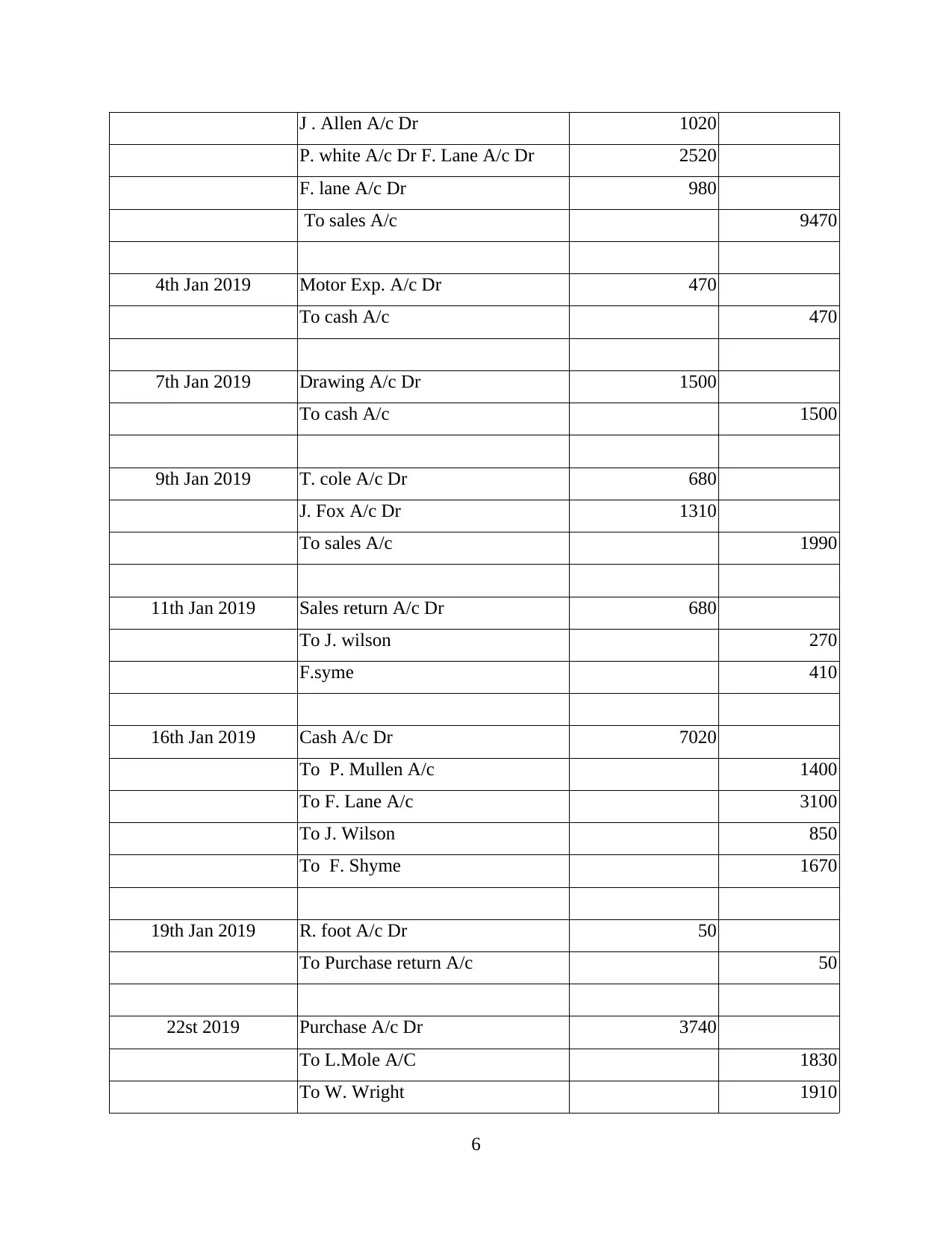
J . Allen A/c Dr 1020
P. white A/c Dr F. Lane A/c Dr 2520
F. lane A/c Dr 980
To sales A/c 9470
4th Jan 2019 Motor Exp. A/c Dr 470
To cash A/c 470
7th Jan 2019 Drawing A/c Dr 1500
To cash A/c 1500
9th Jan 2019 T. cole A/c Dr 680
J. Fox A/c Dr 1310
To sales A/c 1990
11th Jan 2019 Sales return A/c Dr 680
To J. wilson 270
F.syme 410
16th Jan 2019 Cash A/c Dr 7020
To P. Mullen A/c 1400
To F. Lane A/c 3100
To J. Wilson 850
To F. Shyme 1670
19th Jan 2019 R. foot A/c Dr 50
To Purchase return A/c 50
22st 2019 Purchase A/c Dr 3740
To L.Mole A/C 1830
To W. Wright 1910
6
P. white A/c Dr F. Lane A/c Dr 2520
F. lane A/c Dr 980
To sales A/c 9470
4th Jan 2019 Motor Exp. A/c Dr 470
To cash A/c 470
7th Jan 2019 Drawing A/c Dr 1500
To cash A/c 1500
9th Jan 2019 T. cole A/c Dr 680
J. Fox A/c Dr 1310
To sales A/c 1990
11th Jan 2019 Sales return A/c Dr 680
To J. wilson 270
F.syme 410
16th Jan 2019 Cash A/c Dr 7020
To P. Mullen A/c 1400
To F. Lane A/c 3100
To J. Wilson 850
To F. Shyme 1670
19th Jan 2019 R. foot A/c Dr 50
To Purchase return A/c 50
22st 2019 Purchase A/c Dr 3740
To L.Mole A/C 1830
To W. Wright 1910
6
⊘ This is a preview!⊘
Do you want full access?
Subscribe today to unlock all pages.

Trusted by 1+ million students worldwide
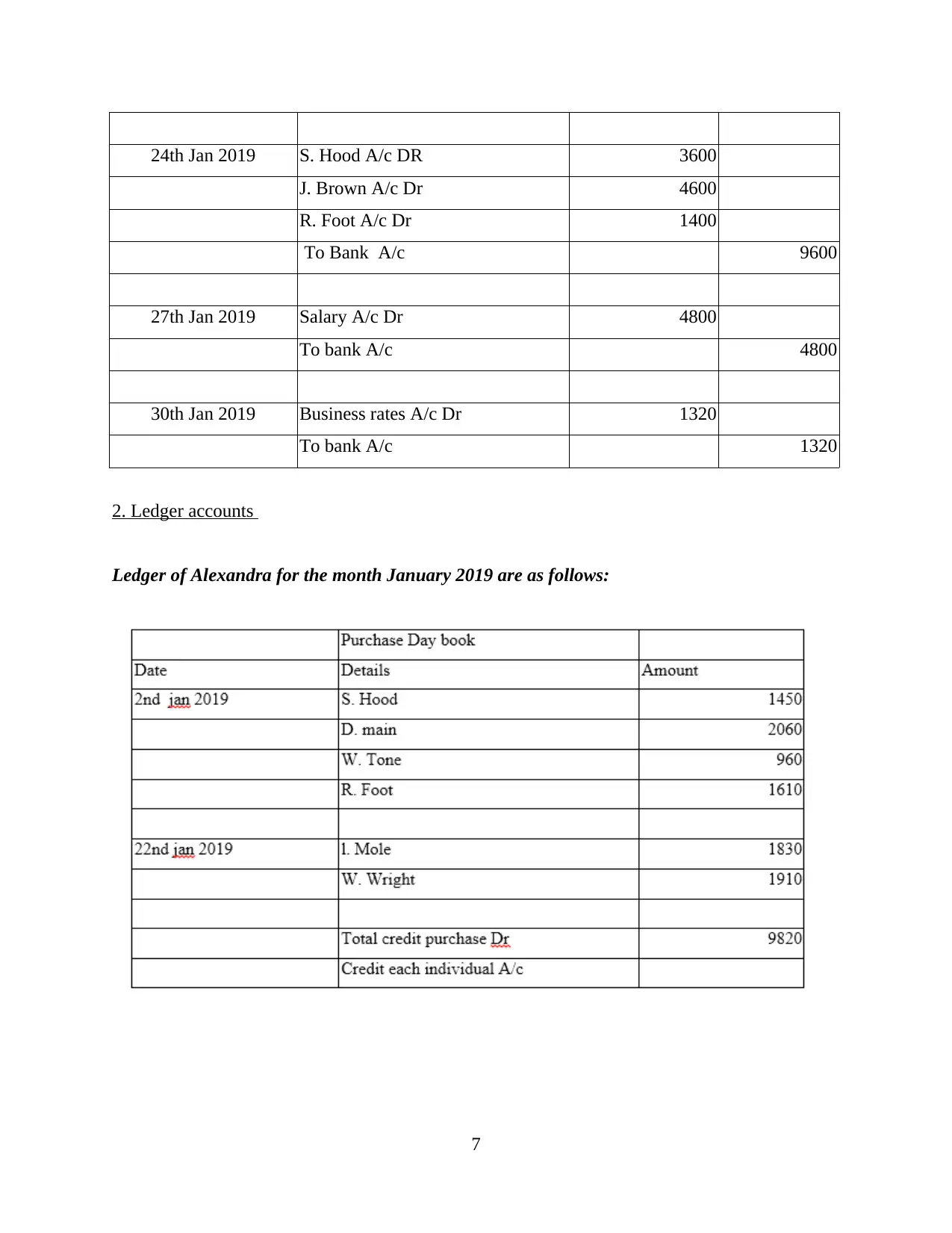
24th Jan 2019 S. Hood A/c DR 3600
J. Brown A/c Dr 4600
R. Foot A/c Dr 1400
To Bank A/c 9600
27th Jan 2019 Salary A/c Dr 4800
To bank A/c 4800
30th Jan 2019 Business rates A/c Dr 1320
To bank A/c 1320
2. Ledger accounts
Ledger of Alexandra for the month January 2019 are as follows:
7
J. Brown A/c Dr 4600
R. Foot A/c Dr 1400
To Bank A/c 9600
27th Jan 2019 Salary A/c Dr 4800
To bank A/c 4800
30th Jan 2019 Business rates A/c Dr 1320
To bank A/c 1320
2. Ledger accounts
Ledger of Alexandra for the month January 2019 are as follows:
7
Paraphrase This Document
Need a fresh take? Get an instant paraphrase of this document with our AI Paraphraser

8
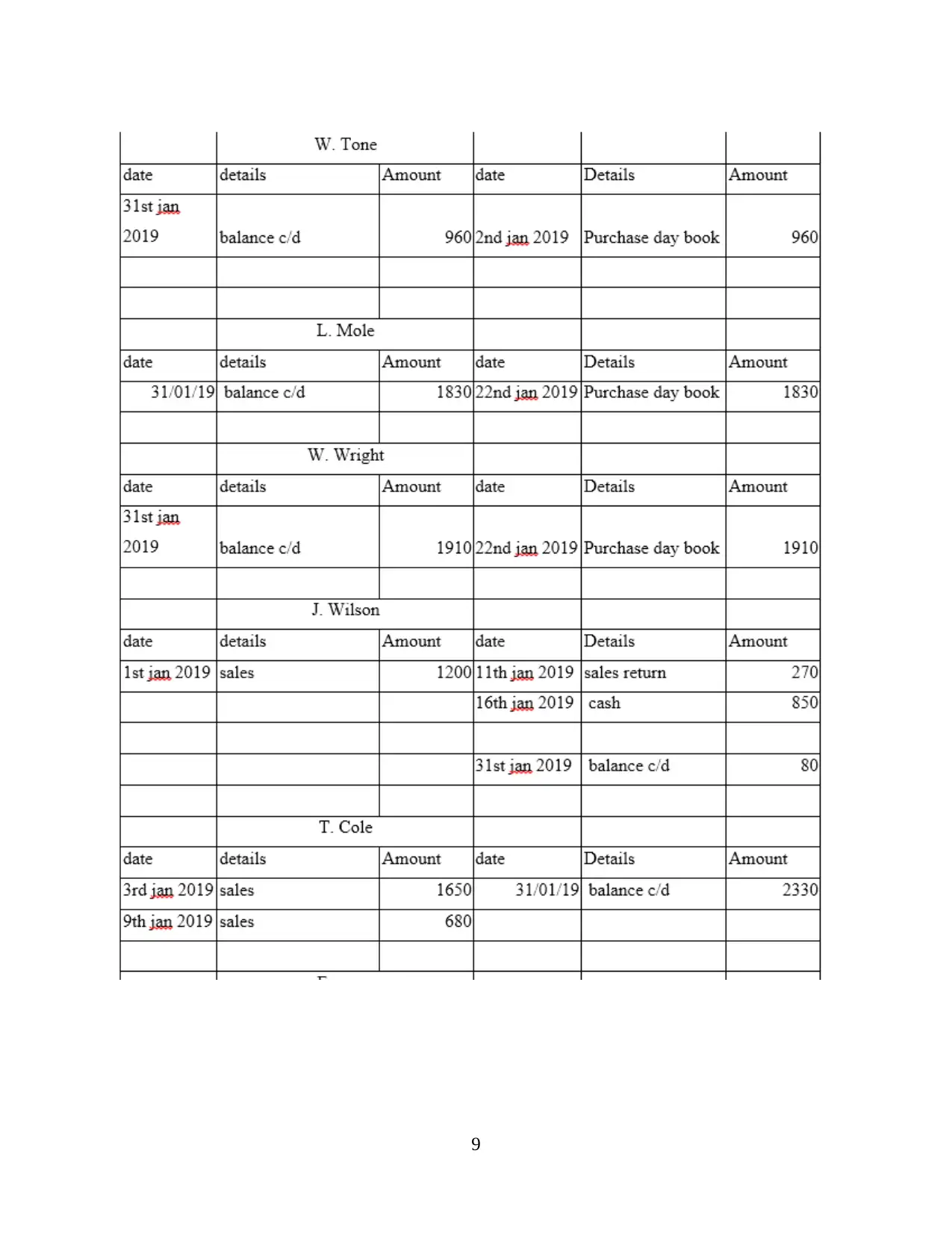
9
⊘ This is a preview!⊘
Do you want full access?
Subscribe today to unlock all pages.

Trusted by 1+ million students worldwide
1 out of 30
Related Documents
Your All-in-One AI-Powered Toolkit for Academic Success.
+13062052269
info@desklib.com
Available 24*7 on WhatsApp / Email
![[object Object]](/_next/static/media/star-bottom.7253800d.svg)
Unlock your academic potential
Copyright © 2020–2025 A2Z Services. All Rights Reserved. Developed and managed by ZUCOL.





